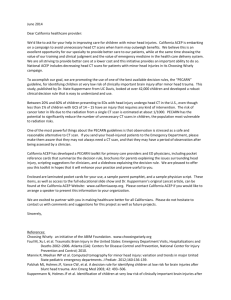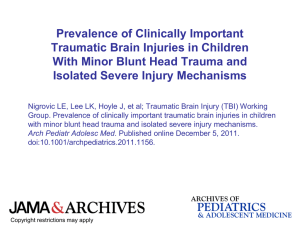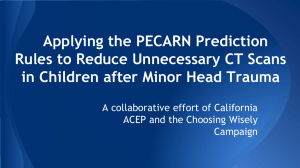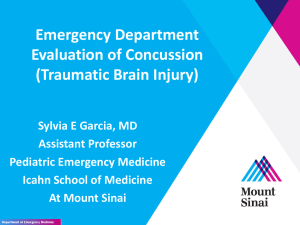Pediatric Diabetic Ketoacidosis
advertisement
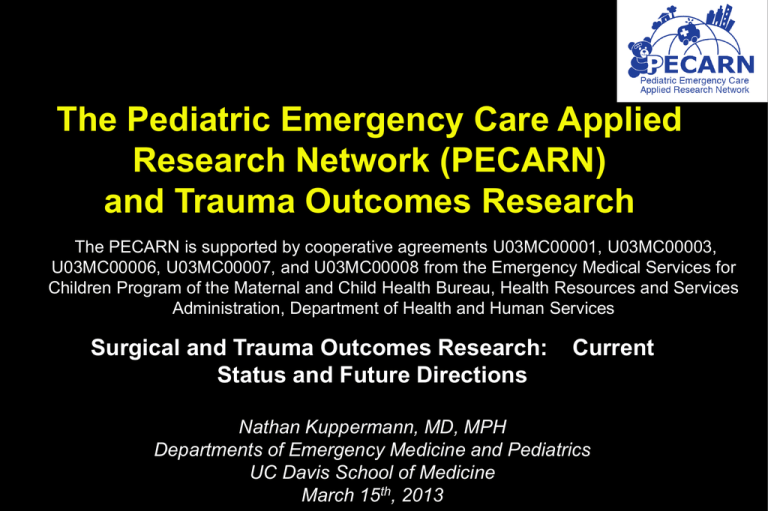
The Pediatric Emergency Care Applied Research Network (PECARN) and Trauma Outcomes Research The PECARN is supported by cooperative agreements U03MC00001, U03MC00003, U03MC00006, U03MC00007, and U03MC00008 from the Emergency Medical Services for Children Program of the Maternal and Child Health Bureau, Health Resources and Services Administration, Department of Health and Human Services Surgical and Trauma Outcomes Research: Status and Future Directions Current Nathan Kuppermann, MD, MPH Departments of Emergency Medicine and Pediatrics UC Davis School of Medicine March 15th, 2013 Disclosure ● No financial or other conflicts of interest What is PECARN? A collaborative research group of hospital EDs organized into nodes and coordinated by a Steering Committee The infrastructure supported by funding from HRSA PECARN • • • works with the EMSC/MCHB/HRSA: multi-center randomized trials observational studies other issues related to emergency medical services for children Highlighted in 2006 IOM reports on the future of EMSC PECARN Structure PECARN Steering Committee Data Coordinating Center (DCC) Quality Assurance, Safety and Regulatory Protocol Review and Development PI: Mike Dean HRSA/ MCHB/ EMSC Grant Writing and Publication Feasibility and Budget Federal Project Officer: Tasmeen Weik PECARN Subcommittees Pediatric Emergency Medicine Northeast, West and South Great Lakes Emergency Medical Services for Children Research Network PEM-NEWS GLEMSCRN PI: Peter Dayan PI: Rachel Stanley Hospitals of the Midwest Emergency Research Node HOMERUN PI: Rich Ruddy Washington, Boston, Chicago Applied Research Node WBCARN PI: Jim Chamberlain Pittsburgh, Rhode Island, Delaware Network PRIDENET Pediatric Research in Injuries and Medical Emergencies PRIME PI: Bob Hickey PI: Nathan Kuppermann PECARN Sites ● ● ● ● ■ ● ● ■= ●= ●= ●= ●= ●= ●= Data Coordinating Center PRIDENET Node PRIME Node GLEMSCRN Node PEM-NEWS Node WBCARN Node HOMERUN Node ● ● ● ● ● ● ● ● ● ● ● ● Ongoing PECARN Research Development Patient safety and error reduction Quality of PEM care Evaluation of head trauma Therapeutic hypothermia in pediatric cardiopulmonary arrest Diagnostic categorization of illnesses and injuries in the PED C-Spine immobilization Management of status epilepticus Steroids in acute bronchiolitis Evaluation of abdominal trauma The burden of mental illness and Progesterone for severe TBI psychiatric emergencies in PED RCT of fluids for DKA Magnesium for sickle cell pain Knowledge translation of TBI rules RNA transcription biosignatures to diagnose febrile infants Childhood Head Trauma: A Neuroimaging Decision Rule Supported by grant R40MC02461-01-00 from EMSC/MCHB/HRSA The PECARN Head Injury Study Goal: to derive a clinical decision rule to accurately identify children at near zero risk of clinically important traumatic brain injury after blunt trauma with high accuracy and wide generalizability Methods ● Design: – Prospective multicenter study over 28 mo. (6/04 – 9/06) in 25 sites in PECARN ● Inclusion Criteria: – Age < 18 years with head trauma evaluated in ED ● Exclusion Criteria: – Ground-level mechanisms and no symptoms or signs of TBI – Penetrating trauma – Injury > 24 hours old – Pre-existing neurological disease impeding assessment – Transfer with neuroimaging already performed Outcome Definition Clinically-important TBI (ciTBI) – – – – Death from TBI Neurosurgical procedure Intubation for > 24 hours for head injury Positive CT in association with hospitalization > 2 nights Variables Considered Age in years 3-level mechanism severity High risk MVC - ejection, rollover, death Ped or unhelmeted bicyclist struck by motorized vehicle Fall > 5 feet (> 3 feet if < 2 yrs) High impact / projectile GCS (14 vs. 15) Other mental status Agitated Sleepy Slow to respond Repetitive Palpable skull fx signs Basilar skull fx signs Amnesia (if > 2 yrs) Bulging fontanelle LOC (duration) Scalp hematoma (location, size, quality) Seizure Focal neurological deficit Acting normal per parent Headache (severity, location) if > 2 yrs Other system injuries Evidence of intoxication Emesis (number, timing) Results 57,030 eligible 2,869 GCS <14 or other exclusion 54,161 GCS 14-15 Not enrolled Enrolled 42,412 (78.3%) 11,749 (21.7%) Derivation 33,785 Validation 8,627 288 ciTBI 88 ciTBI (0.9%) (1.0%) Inter-observer agreement 0 m e c ha nis m o f injury m e c ha nis m o f injury ( lo w v s . high ris k ) dizzine s s a m ne s ia f o r e v e nt a ny LO C LO C dura t io n* s e izure a c t ing no rm a l pe r pa re nt he a da c he he a da c he s e v e rit y* v o m it ing v o m it ing f re que nc y* pa lpa ble f ra c t ure bulging f o nt a ne lle ( a ge <2 o nly) ba s ila r f ra c t ure he m a t o m a pre s e nt he m a t o m a lo c a t io n he m a t o m a s ize * he m a t o m a qua lit y a ny s ign o f t ra um a a bo v e c la v ic le s f o c a l ne uro lo gic de f ic it o t he r s ubs t a nt ia l injury int o xic a t io n GC S* G C S 15 v s <15 o t he r s igns o f a lt e re d m e nt a l s t a t us a git a t e d s lo w t o re s po nd s le e py re pe t it iv e ( a ge >=2 o nly) a ny s igns o f a lt e re d m e nt a l s t a t us 0.2 Kappa 0.4 0.6 0.8 1 Kuppermann/Holmes, 2009 The PECARN TBI Rules (derived and validated) Children are at very low risk of clinically-important traumatic brain injury (TBI) if they meet all criteria in age-specific rule: Children < 2 years Children 2-18 years Severe mechanism of injury History of LOC > 5 sec GCS = 14 or other signs of altered mental status Not acting normally per parent Palpable skull fracture Occipital/parietal/temporal scalp hematoma Severe mechanism of injury History of LOC GCS = 14 or other signs of altered mental status History of vomiting Severe headache in the ED Signs of basilar skull fracture Under 2 years Over 2 years Recommendations for children younger than 2 The Rule Recommendations for children younger than 2 Suggestions Recommendations for children 2 years and older The Rule Recommendations for children 2 years and older Suggestions PECARN Clinical Prediction Rule for Abdominal CT in Pediatric Trauma ● Prospective multicenter study 2007 - 2010 – < 18 years with blunt abdominal trauma – Clinical data recorded before abd CT (if done) – Follow-up obtained on all patients: ● Discharged patient: telephone follow-up Admitted patients: medical record review Primary outcome: IAI requiring therapy (IAIAI) – Recursive partitioning analysis – 761 (6.3%) with IAI and 203 (1.7%) with IAIAI Prediction Rule for IAIAI (n=12,044) 1,963 patients 112 (5.7%) IAIAI Abdominal Wall Trauma No Sensitivity = 197/203 (97.0%; 95% CI 93.7, 98.9%) Specificity = 5028/11841 (42.5%; 95% CI 41.6, 43.4%) 826 patients 38 (4.6%) IAIAI GCS < 14 No NPV = 5028/5034 (99.9%; 95% CI 99.7, 100%) LR- = 0.07 (95% CI 0.03, 0.15) 2,532 patients 36 (1.4%) IAIAI Abdomen tender No 955 patients 6 (0.6%) IAIAI Thoracic Trauma No 305 patients 2 (0.7%) IAIAI Abdominal pain No ↓ Breath Sounds No 34 patients 1 (2.9%) IAIAI Emesis No 1,234 CT scans (25%) 5,034 patients 395 patients 2 (0.5%) IAIAI 6 (0.1%) IAIAI Holmes/Kuppermann, 2013 How to get clinicians to use the prediction rules? Knowledge Translation Pipeline ● EBM – continuum here Glasziou/Haynes, 2005 Translating Research into Practice What works Clinical decision support more successful when: ● ● ● ● Automatic provision of support in workflow Recommendations given rather than risks Support given at the time and location of decision-making Support is computer based Kawamoto, 2005 Implementation of the PECARN Traumatic Brain Injury Prediction Rules Using Electronic Health Record-Based Clinical Decision Support: An Interrupted Time Series Trial Funded by the American Recovery and Reinvestment Act – Office of the Secretary: Grant #S02MC19289-01-00 Data Completion by Nursing If Triage RN enters “Yes-less than 24 hours ago” items for risk assessment will be cascade Blunt Head Trauma Assessment Courtesy: Peter S. Dayan, MD, PECARN Clinical Decision Support • Clinician receives a statement no matter what is entered • Formatted similarly across statements 1. Recommendation 2. Risk estimate of clinically-important TBI based on PECARN data 3. Details regarding recommendations/risks 4. List of predictors and responses 5. Links to useful information(e.g. the prediction rules) Decision Support: Patient < 2 years who meets rule Methods – design Interrupted Time Series Trial with Concurrent Controls Month of Trial 0 1 2 3 4 5 6 7 8 9 10 11 12 13 14 15 16 17 18 19 20 21 22 23 24 25 26 27 28 29 Pre-intervention phase Intervention implemented Intervention maintained (post-intervention phase) Main Comparisons: Pre to post int. Intervention Group Measurement (receives CDS) Baseline rate of CT use Post-intervention rate of CT use Control Group Measurement (standard of care) Rate of CT use measured throughout the study period Selected References 1.Glasziou P, Haynes B. The paths from research to improved health outcomes. ACP J Club 2005;142:A8-10. 2.Graham ID, Stiell IG, Laupacis A, O’Connor AM, Wells GA. Emergency physicians’ attitudes toward and use of clinical decision rules for radiography. Acad Emerg Med 1998;5:134-40. 3.Holmes JF, Lillis K, Monroe D, Borgialli D, Kerrey BT, Mahajan P et al and PECARN. Identifying children at very low risk of clinically-important blunt abdominal. Ann Emerg Med 2013 [Epub ahead of print]. 4.Kawamoto K, Houlihan CA, Balas EA, Lobach DF. Improving clinical practice using clinical decision support systems: a systematic review of trials to identify features critical to success. BMJ 2005;330:765 [Epub]. 5.Kuppermann N, Holmes JF, Dayan PS, Hoyle JD Jr, Atabaki SM, Holubkov R et al and PECARN. Identification of children at very low risk of clinically-important brain injuries after head trauma: a prospective cohort study. Lancet 2009;374:1160-70. 6.Laupacis A, Sekar N, Stiell IG. Clinical prediction rules: a review and suggested modifications of methodological standards. JAMA 1997;277:488-494. Selected References 7.Maguire JL, Kulik DM, Laupacis A, Kuppermann N, Uleryk EM, Parkin PC.Clinical prediction rules for children: a systematic review. Pediatrics 2011;128:e666-77. 8.Palchak MJ, Holmes JF, Vance CW, et al. A decision rule for identifying children at low risk for brain injuries after blunt head trauma. Ann Emerg Med 2003;42:492-506. 9.Stiell IG, Wells GA. Methodologic standards for the development of clinical decision rules in emergency medicine. Ann Emerg Med 1999;33:437-447. 10.The Pediatric Emergency Care Applied Research Network. The Pediatric Emergency Care Applied Research Network (PECARN): Rationale, development, and first steps. Acad Emerg Med 2003;10:661-668.
